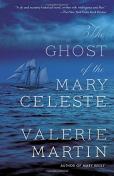BKMT READING GUIDES
The Ghost of the Mary Celeste (Vintage Contemporaries)
by Valerie Martin
Paperback : 320 pages
1 club reading this now
0 members have read this book
As news of the derelict ghost ship spreads, the Mary Celeste captures ...
Introduction
1872: the American merchant vessel Mary Celeste is discovered adrift off the coast of Spain. Her cargo is intact and there is no sign of struggle, but her crew has disappeared, never to be found.
As news of the derelict ghost ship spreads, the Mary Celeste captures imaginations around the world—from a Philadelphia spiritualist medium named Violet Petra to an unknown young writer named Arthur Conan Doyle. In a haunted, death-obsessed age, the Mary Celeste is by turns a provocative mystery, an inspiration to creativity, and the tragic story of a family doomed by the sea. Based on actual events, spanning seas and continents, life and death, The Ghost of the Mary Celeste is a spellbinding exploration of love, nature, and the fictions that pass as truth.
Editorial Review
About the Writing of The Ghost of the Mary Celeste, by Valerie Martin
I first read about the ghost ship the Mary Celeste when I was in fifth grade â?? I think it must have been an article in the Weekly Reader, the childrenâ??s newspaper my school subscribed to and which I looked forward to with modest excitement every Friday. Iâ??m sure the article barely sketched out the story - a ship sighted drifting at sea in some sort of trouble, with no sailor at the helm; the boarding of the Mary Celeste by the anxious crew of a passing ship; the discovery that there was no one aboard; the evidence that the crew had left on the shipâ??s boat and in a hurry; and the perplexing problem - the mystery - of their motive for abandoning the ship, which was fully provisioned and in seaworthy condition. â??Fit,â?? as one of the salvers would testify in the salvage hearing at Gibraltar, â??to sail round the world.â??
A few years ago, by accident and Iâ??m still not sure where, I learned that the missing crew of the Mary Celeste included the captainâ??s wife and his baby daughter. This detail caught my attention because I was under the impression that sailors considered women aboard ships bad luck. I began some superficial research about the subject â?? trawling a few nets in the wake of the Mary Celeste, and quickly uncovered a world Iâ??d never dreamed of.
Throughout the 19th century, women regularly sailed on the vessels that plowed the seas, and it was not uncommon for children to be born aboard ship. Especially on whalers, which would be out at sea for years on end, wives took the opportunity of going along with their husbands. One whaling captain delivered all five of his children on his ship, and some of these learned to walk on a deck before they put their little feet on land. The captainâ??s wife and family were such an ordinary component of seagoing commerce that the sailors had a name for ships with a wife and children in the aft cabin â?? they called them â??hen frigates.â??
When a captain married, the couple might combine his business with their pleasure and take a honeymoon trip. This was the case with Capt. Benjamin Briggs and his wife Sarah Cobb Briggs, who sailed to Genoa shortly after their marriage in Marion, Massachusetts. In the fall of 1872, Benjamin Briggs purchased a one/fifth interest in a newly fitted ship and signed on to sail her to Messina, a trip that would take about three months. Sarah Briggs, who disliked sailing, decided to join him, taking their two-year-old daughter along. As she wrote to her mother-in-law, â??Going to sea in itself considered is anything but agreeable, at least to me, but if Benja must go I would gladly go when I could.â?? On October 26, having shipped ahead her melodeon, sewing machine, two boxes of music books, toys, and clothes for herself and her daughter Sophia, she took the train to New York and joined her husband at Pier 8 to board their ship the Mary Celeste.
Before long, investigation of the events that followed turned up an unexpected name: Arthur Conan Doyle.
The future creator of Sherlock Holmes was a boy when the Mary Celeste was recovered and doubtless followed the news stories about the salvage trial in Gibraltar that appeared in the British and American press. Twelve years later, when he was a struggling young doctor in Edinburgh, Doyle published a story in the Cornhill magazine that purported to be a true account of the lone survivor of the Mary Celeste. Though Doyle altered the name of the ship and changed the captainâ??s name, the publicâ??s imagination was fired by this tale and to this day certain details entirely invented by the young Dr. Arthur Conan Doyle, who longed to make his way as a writer, continue to be attached to new accounts, fictional and otherwise, about the famous ghost ship, the Mary Celeste.
Even a superficial study of the life of Arthur Conan Doyle bangs up against the 19th century Spiritualist movement, which was spawned in upstate New York and quickly spread across the country and abroad. The craze for mediums, séances, spirit writing, spirit photography, spirit guides, table turning, apparitions, and the materialization of ectoplasm excited the interest of a credulous public, as well as an alarming number of prominent and intelligent men and women. Horace Greeley, Alfred Russel Wallace, William James and his brother Henry James, Elizabeth Barrett Browning, Mary Todd and Abraham Lincoln and even Queen Victoria indulged in séances and clairvoyant lectures. Many of these notables were ultimately disabused of their fascination, but Arthur Conan Doyle became a committed Spiritualist. He gave up writing and spent the last five years of his life traveling the world to spread the good news that life is continuous and that the dead only wait for our attention to make themselves known again.
These three elements, a ship found sailing without a crew, a famous writer on the verge of enormous success, and the rise of an unorthodox and heretical religious fervor, began to work in my imagination, and I knew I was on the track of an historical novel. In my researches the fantastic and the banal, the absurd and the tragic seemed woven into an intricate and radiant fabric, one spun from facts and fictions in much the same way everyday life spins out, one story generating another, a thread disappearing in one corner and reappearing surprisingly near the center.
Discussion Questions
No discussion questions at this time.Book Club Recommendations
Recommended to book clubs by 0 of 0 members.
Book Club HQ to over 90,000+ book clubs and ready to welcome yours.
Get free weekly updates on top club picks, book giveaways, author events and more








